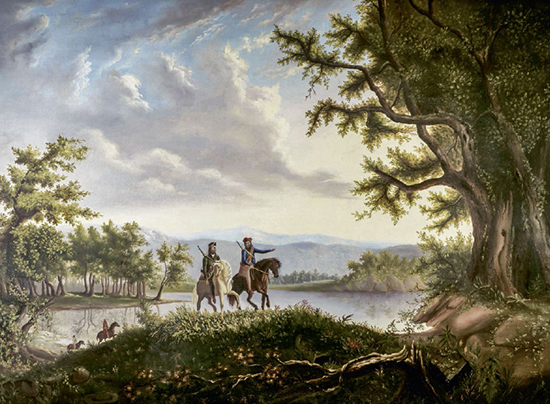1804
Charting North America
Meriwether Lewis (1774–1809), William Clark (1770–1838)
The era of government-sponsored voyages of exploration that also made meaningful scientific discoveries arguably began with the seafaring expedition of British Captain James Cook and the crew of the HMS Endeavour, sent to Tahiti to observe and record the transit of Venus in 1769. In overland travel, among the earliest and most noted such voyages was the nearly 8,000-mile (13,000-kilometer) trek of the specially commissioned (by President Jefferson) Corps of Discovery expedition between 1804 and 1806, led by Meriwether Lewis and William Clark.
President Thomas Jefferson had just completed making the Louisiana Purchase from France and was keen to see that new territory surveyed and US sovereignty declared over its native inhabitants. He also wanted to stake a claim to the Pacific Northwest territories that had not, as of yet, been claimed by any European powers. Thus, Jefferson dispatched Lewis, Clark, and thirty others on a Congressionally funded journey from St. Louis to the Pacific Ocean. While the purpose of the expedition was not scientific discovery per se, the Corps was charged with accurately cataloguing the flora, fauna, climate, and geography along their route, and was thus equipped with a variety of scientific instruments and was trained in some aspects of the relevant sciences.
Following the Missouri River upstream to its headwaters in the Rocky Mountains, the expedition encountered, traded with, and learned from several Native American tribes, avoiding conflict for the most part, and making careful observations and records of what they encountered along the way. The Rockies proved to be an obstacle to Jefferson’s hope for a continuous river route to the Pacific, and the Corps struggled to traverse the tall, snowy peaks. Guidance and material help from Native American tribes along the way proved critical to the survival of the group. Eventually, the Snake and Columbia rivers provided their path to the Pacific, where they arrived in late 1805. They returned to St. Louis in 1806.
The expedition resulted in the discovery and description of more than 200 new species of plants and animals, and the establishment of peaceful contact (at least for the time being) with more than 70 Native American tribes.
SEE ALSO Circumnavigating the Globe (1519), Transit of Venus (1769), Modern Geologic Maps (1815), Exploring the Grand Canyon (1869), National Parks (1872)
Mid-nineteenth century painting by artist Thomas Burnham of Lewis and Clark scouting ahead during their 1804 expedition to the American Northwest.
